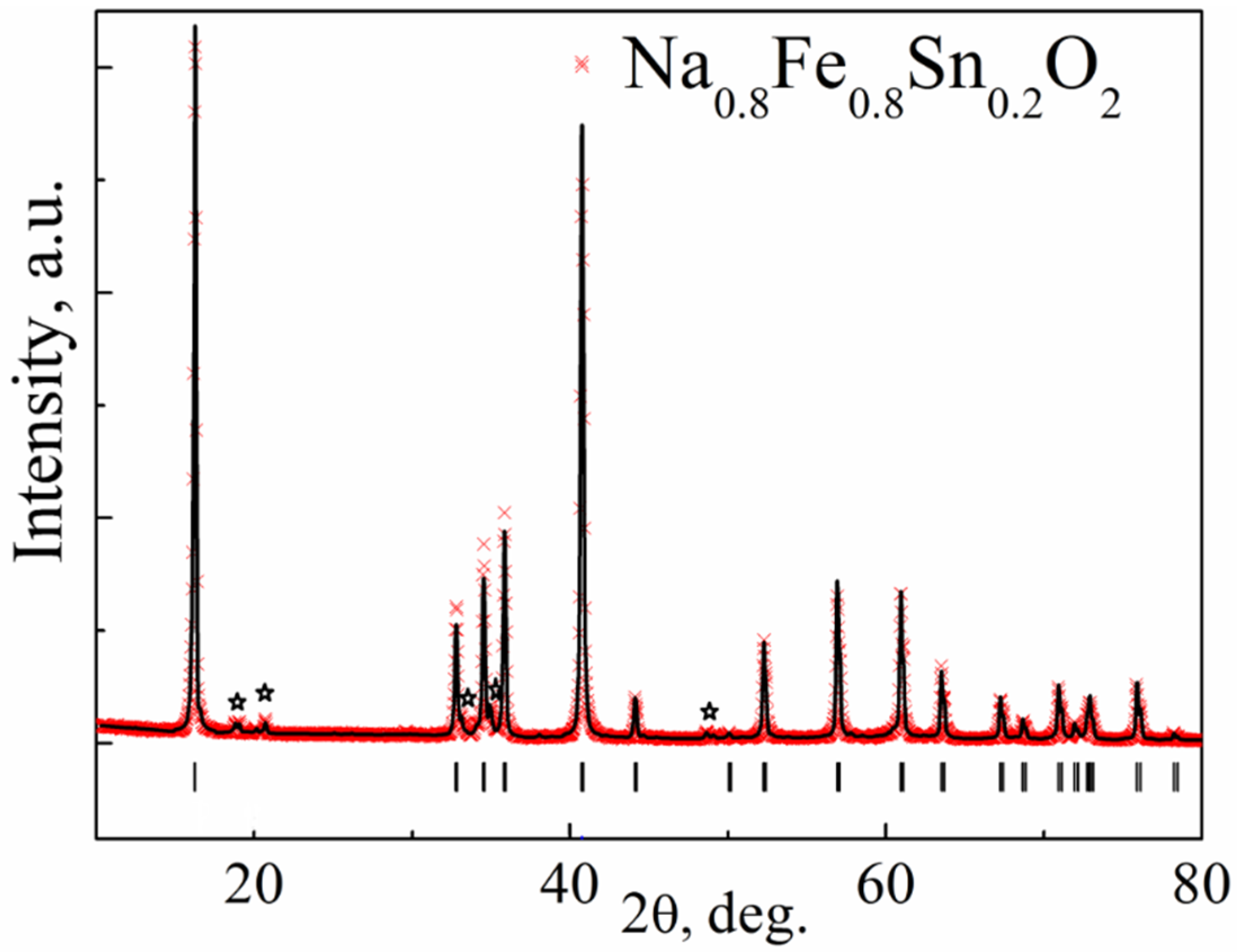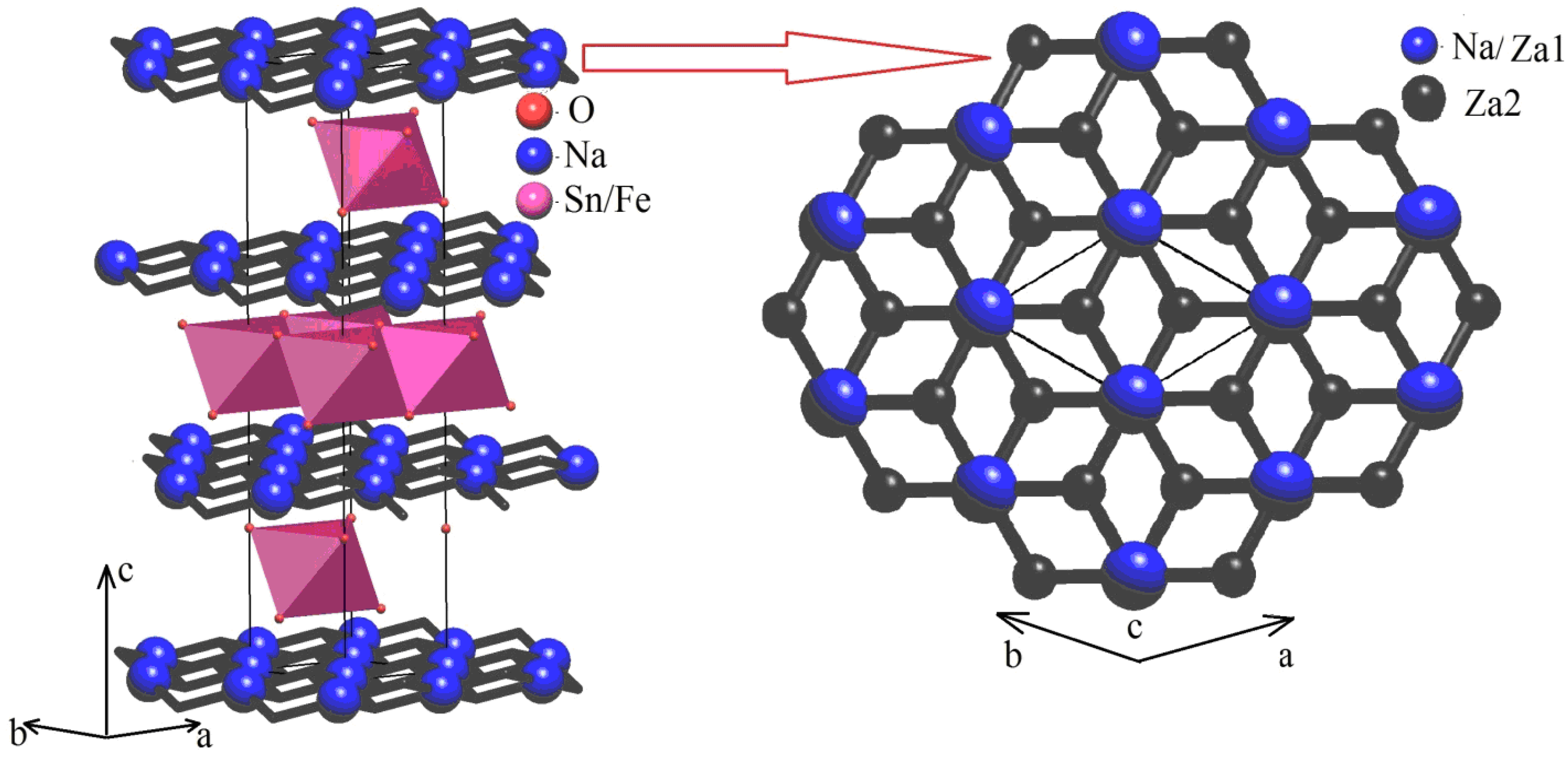Phase Relations in a NaFeO2-SnO2 (0–50 mol.% SnO2) System and the Crystal Structure and Conductivity of Na0.8Fe0.8Sn0.2O2
Abstract
:1. Introduction
2. Materials and Methods
2.1. Sample Preparation
2.2. Characterization and Electrical Measurements
3. Results and Discussion
3.1. XRD Analysis and Phase Relations
3.2. Morphology Study and Thermal Analysis
3.3. Crystal Structure of Na0.8Fe0.8Sn0.2O2
3.4. Conductivity Study
3.5. Exploration of the Migration Map of Na+ Cations
4. Conclusions
Author Contributions
Funding
Institutional Review Board Statement
Informed Consent Statement
Data Availability Statement
Acknowledgments
Conflicts of Interest
References
- Julien, C. Technological Applications of Solid State Ionics. Mater. Sci. Eng. 1990, 6, 9–28. [Google Scholar] [CrossRef]
- Jung, K.; Heo, H.-J.; Lee, J.-H.; Park, Y.C.; Kang, C.-Y. Enhanced corrosion resistance of Hypo-eutectic Al-1Mg-xSi alloys against molten sodium attack in high temperature sodium-sulfur batteries. Corros. Sci. 2015, 98, 748–757. [Google Scholar] [CrossRef]
- Chang, R.; Minck, R. Sodium-sulfur battery flight experiment definition study. J. Power Sources 1990, 29, 555–563. [Google Scholar] [CrossRef] [Green Version]
- Anantharamulu, N.; Koteswara Rao, K.; Rambabu, G.B.; Kumar, V.; Velchuri, R.; Vithal, M. A wide-ranging review on Nasicon type materials. J. Mater. Sci. 2011, 46, 2821–2837. [Google Scholar] [CrossRef]
- Maruyama, T.; Saito, Y.; Matsumoto, Y.; Yano, Y. Potentiometric sensor for sulfur oxides using NASICON as a solid electrolyte. Solid State Ion. 1985, 17, 281–286. [Google Scholar] [CrossRef]
- Bruce, P.G. Energy storage beyond the horizon: Rechargeable lithium batteries. Solid State Ion. 2008, 179, 752–760. [Google Scholar] [CrossRef]
- Scrosati, B.; Garche, J. Lithium batteries: Status, properties and future. J. Power Sources 2010, 195, 2419–2430. [Google Scholar] [CrossRef]
- Robertson, A.D.; West, A.R.; Ritchie, A.G. Review of crystalline lithium-ion conductors suitable for high temperature battery applications. Solid State Ion. 1997, 104, 1–11. [Google Scholar] [CrossRef]
- Thangadurai, V.; Weppner, W. Recent progress in solid oxide and lithium ion conducting electrolytes research. Ionics 2006, 12, 81–92. [Google Scholar] [CrossRef] [Green Version]
- Knauth, P. Inorganic solid Li-ion conductors: An overview. Solid State Ion. 2009, 180, 911–916. [Google Scholar] [CrossRef]
- Bachman, J.C.; Muy, S.; Grimaud, A.; Chang, H.-H.; Pour, N.; Lux, F.S.; Paschos, O.; Maglia, S.; Lupart, S.; Lamp, P.; et al. Inorganic Solid-State Electrolytes for Lithium Batteries: Mechanisms and Properties Governing Ion Conduction. Chem. Rev. 2016, 116, 140–162. [Google Scholar] [CrossRef] [PubMed]
- Hwang, J.-Y.; Myung, S.-T.; Sun, J.-K. Sun Sodium-ion batteries: Present and future. Chem. Soc. Rew. 2017, 46, 3529–3614. [Google Scholar] [CrossRef] [PubMed] [Green Version]
- Nayak, P.K.; Yang, L.; Brehm, W.; Adelhelm, P. From Lithium-Ion to Sodium-Ion Batteries: Advantages, Challenges and Surprises. Angew. Chem. Int. Ed. 2018, 57, 102–120. [Google Scholar] [CrossRef]
- Delmas, C. Sodium and Sodium-Ion Batteries: 50 Years of Research. Adv. Energy. Mater. 2018, 8, 1703137. [Google Scholar] [CrossRef]
- Fergus, J.W. Ion transport in sodium ion conducting solid electrolytes. Solid State Ion. 2012, 227, 102–112. [Google Scholar] [CrossRef]
- Meutzner, F.; Munchgesang, W.; Kabanova, N.A.; Zschornak, M.; Leisegang, T.; Blatov, V.A.; Meyer, D.C. On the Way to New Possible Na-Ion Conductors: The Voronoi-Dirichlet Approach, Data Mining and SymmetryConsideration in Ternary Na Oxides. Chem. Eur. J. 2015, 21, 16601–16608. [Google Scholar] [CrossRef]
- Yang, C.; Xin, S.; Mai, L.; You, Y. Materials Design for High-Safety Sodium-Ion Battery. Adv. Energy Mater. 2020, 11, 2000974. [Google Scholar] [CrossRef]
- Chayambuka, K.; Mulder, G.; Danilov, D.L.; Notten, P.H.L. Sodium-Ion Battery Materials and Electrochemical Properties Reviewed. Adv. Energy. Mater. 2018, 8, 1800079. [Google Scholar] [CrossRef]
- Zhao, C.; Wang, Q.; Yao, Z.; Wang, J.; Sanchez-Lengeling, B.; Ding, F.; Qi, X.; Lu, Y.; Bai, X.; Li, B.; et al. Rational design of layered oxide materials for sodium-ion batteries. Sciense 2020, 370, 708–711. [Google Scholar] [CrossRef]
- Skundin, A.M.; Kulova, T.L.; Yaroslavtsev, A.B. Sodium-Ion Batteries (A Review). Russ. J.Electrochem. 2018, 54, 131–174. [Google Scholar] [CrossRef]
- Fedotov, S.S.; Kabanova, N.A.; Kabanov, A.A.; Blatov, V.A.; Khasanova, N.R.; Antipov, E.V. Crystallochemical tools in the search for cathode materials of rechargeable Na-ion batteries and analysis of their transport properties. Solid State Ion. 2018, 314, 129–140. [Google Scholar] [CrossRef]
- Han, J.; Niu, Y.; Zhang, Y.; Jiang, J.; Bao, S.; Hu, M. Evaluation of O3-type Na0.8Ni0.6Sb0.4O2 as cathode materials for sodium-ion batteries. J. Solid State Electrochem. 2016, 20, 2331–2335. [Google Scholar] [CrossRef]
- Smirnova, O.A.; Fuentes, R.O.; Figueiredo, F.; Kharton, V.V.; Marques, F.M.B. Stability and Termal Expansion of Na+-Conducting Ceramics. J. Electroceram. 2003, 11, 179–189. [Google Scholar] [CrossRef]
- Li, X.; Wu, D.; Zhou, Y.N.; Liu, L.; Yang, X.-Q.; Ceder, G. A quaternary layered cathode compound or rechargeable Na ion batteries. Electrochem. Commun. 2014, 49, 51–54. [Google Scholar] [CrossRef] [Green Version]
- Maazaz, A.; Delmas, C.; Fouassier, C.; Reau, J.-M.; Hagenmuller, P. Sur une nouvelle famille de formule Kx(Lx/2Sn1-x/2)O2 (L = Mg, Ca, Zn; x < 1). Mater. Res. Bull. 1979, 14, 193–199. [Google Scholar] [CrossRef]
- Delmas, C.; Fouassier, C.; Hagenmuller, P. Structural classification and properties of the layered oxides. Phys. BC 1980, 99, 81–85. [Google Scholar] [CrossRef]
- Yoshida, H.; Yabuuchi, N.; Komaba, S. NaFe0.5Co0.5O2 as high energy and power positive electrode for Na-ionbatteries. Electrochem. Commun. 2013, 80, 716–719. [Google Scholar] [CrossRef] [Green Version]
- Zhao, J.; Zhao, L.; Dimov, N.; Okada, S.; Nashida, T. Electrochemical and Thermal Properties of α-NaFeO2 Cathodefor Na-Ion Batteries. J. Electrochem. Soc. 2013, 160, A3077–A3081. [Google Scholar] [CrossRef]
- Thorne, J.S.; Chowdhury, S.; Dunlap, R.A.; Obrovac, M.N. Structure and Electrochemistry ofNaxFexTi1-xO2 (1.0 ≥ x ≥ 0.75) for Na-Ion Battery Positive Electrodes. J. Electrochem. Soc. 2014, 161, A1801–A1805. [Google Scholar] [CrossRef]
- Susanto, D.; Cho, M.K.; Ghulam, A.; Kim, J.-Y.; Chang, H.J.; Kim, H.-S.; Nam, K.-W.; Chung, K.Y. Anionac Redox Acivity as a Key Factor in the Performance Degradation of NaFeO2 Cathodes for Sodium Ion Batteries. Chem. Mater. 2019, 31, 3644–3651. [Google Scholar] [CrossRef]
- Li, C.; Reid, A.F.; Saunders, S. Nonstoihiometric Alkali Ferrites and Aluminates in the Systems NaFeO2-TiO2,KFeO2-TiO2, KAlO2-TiO2 and KAlO2-SiO2. J. Solid State Chem. 1971, 3, 614–620. [Google Scholar] [CrossRef]
- Burmakin, E.I.; Shekhtman, G.S. Solid electrolytes in the Fe2O3-TiO2-Na2O system. Elektrokhimiya 1985, 21, 752–757. (In Russian) [Google Scholar]
- Rodriguez-Carvajal, J. Recent advances in magnetic structure determination by neutron powder diffraction. Physica 1993, 192B, 55–69. [Google Scholar] [CrossRef]
- Anurova, N.A.; Blatov, V.A. Analysis of ion-migration paths in inorganic frameworks by means of tilings and Voronoi–Dirichlet partition: A comparison. Acta Cryst. 2009, 65, 426–434. [Google Scholar] [CrossRef]
- Anurova, N.A.; Blatov, V.A.; Ilyushin, G.D.; Blatova, O.A.; Ivanov-Schits, A.K.; Demy’anets, L.N. Migration maps of Li+ cations in oxygen-containing compounds. Solid State Ion. 2008, 179, 2248–2254. [Google Scholar] [CrossRef]
- Takeda, Y.; Akagi, J.; Edagawa, A.; Inagaki, M.; Naka, S. A preparation and polymorphic relations of sodium iron oxide (NaFeO2). Mat. Res. Bull. 1980, 15, 1167–1172. [Google Scholar] [CrossRef]
- Collongues, R.; Thery, J. Preparation et Proprietes des Ferrites de Sodium. Bull. Soc. Chim. France 1959, 51, 1141–1144. [Google Scholar] [CrossRef]
- West, A.R. NaAlO2 and NaFeO2Polymorphism. Nature 1974, 249, 245–246. [Google Scholar] [CrossRef]
- Grey, I.E.; Hill, R.J.; Hewatt, A.W. A neutron powder diffraction study of the β to γ phase transformation in NaFeO2. Z. Krist. 1990, 193, 51–69. [Google Scholar] [CrossRef]
- Ito, J.; Frondel, C. Synthetic zirconium and titanum garnets. Amer. Mineral. 1967, 52, 773–781. [Google Scholar]
- Shannon, R.D. Revised effective ionic radii and systematic studies of interatomic distances in halides and chalcogenides. Acta Cryst. 1976, 32, 751–767. [Google Scholar] [CrossRef]
- Breger, J.; Jiang, M.; Dupre, N.; Meng, Y.S.; Yang, S.-H.; Ceder, G.; Grey, C.P. High-resolution X-ray diffraction, DIFFaX, NMR and first principles study of disorder in the Li2MnO3—Li[Ni1/2Mn1/2]O2 solid solutions. J. Solid State Chem. 2005, 178, 2575–2585. [Google Scholar] [CrossRef]
- Baroudi, K.; Yim, C.; Wu, H.; Huang, O.; Roudebush, J.H.; Vavilova, E.; Grafe, H.-J.; Kataev, V.; Buechner, B.; Ji, H.; et al. Structure and properties of α-NaFeO2-type ternary sodium iridates. J. Solid State Chem. 2014, 210, 195–205. [Google Scholar] [CrossRef] [Green Version]
- Blatov, V.A. Multipurpose crystallochemical analysis with the program package TOPOS. IUCr Comput. Comm. Newsl. 2006, 7, 4. [Google Scholar]
- Fedotov, S.S.; Kabanov, A.A.; Kabanova, N.A.; Blatov, V.A.; Zhugayevych, A.; Abakumov, A.M.; Khasanova, N.R.; Antipov, E.V. Crystal Structure and Li-Ion Transport in Li2CoPO4F High-Voltage Cathode Material for Li-Ion Batteries. J. Phys. Chem. 2017, 121C, 3194–3202. [Google Scholar] [CrossRef]
- Sridharan, R.; Gnanasekaran, T.; Mathews, C.K. Phase equilibrium studies in the Na-Fe-O system. J. Alloys Compd. 1993, 191, 9–13. [Google Scholar] [CrossRef]









| Refined Structural Parameters | Atom | ||
|---|---|---|---|
| Na (3b) | Fe/Sn (3a) | O (6c) | |
| Atom coordinates | 001/2 | 000 | 00z |
| Thermal parameters, Å2 | 1.31(4) | 0.71(2) | 0.52(4) |
| χ2 | 3.651 | ||
| Bragg R-factor | 2.91 | ||
Publisher’s Note: MDPI stays neutral with regard to jurisdictional claims in published maps and institutional affiliations. |
© 2022 by the authors. Licensee MDPI, Basel, Switzerland. This article is an open access article distributed under the terms and conditions of the Creative Commons Attribution (CC BY) license (https://creativecommons.org/licenses/by/4.0/).
Share and Cite
Shekhtman, G.S.; Sherstobitova, E.A.; Shchelkanova, M.S.; Ilyina, E.A. Phase Relations in a NaFeO2-SnO2 (0–50 mol.% SnO2) System and the Crystal Structure and Conductivity of Na0.8Fe0.8Sn0.2O2. Materials 2022, 15, 3612. https://doi.org/10.3390/ma15103612
Shekhtman GS, Sherstobitova EA, Shchelkanova MS, Ilyina EA. Phase Relations in a NaFeO2-SnO2 (0–50 mol.% SnO2) System and the Crystal Structure and Conductivity of Na0.8Fe0.8Sn0.2O2. Materials. 2022; 15(10):3612. https://doi.org/10.3390/ma15103612
Chicago/Turabian StyleShekhtman, Georgiy S., Elena A. Sherstobitova, Mariya S. Shchelkanova, and Evgenia A. Ilyina. 2022. "Phase Relations in a NaFeO2-SnO2 (0–50 mol.% SnO2) System and the Crystal Structure and Conductivity of Na0.8Fe0.8Sn0.2O2" Materials 15, no. 10: 3612. https://doi.org/10.3390/ma15103612
APA StyleShekhtman, G. S., Sherstobitova, E. A., Shchelkanova, M. S., & Ilyina, E. A. (2022). Phase Relations in a NaFeO2-SnO2 (0–50 mol.% SnO2) System and the Crystal Structure and Conductivity of Na0.8Fe0.8Sn0.2O2. Materials, 15(10), 3612. https://doi.org/10.3390/ma15103612







